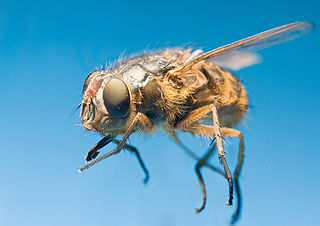
The Calliphoridae are a family of insects in the order Diptera, with 1,200 known species. The maggot larvae, often used as fishing bait, are known as gentles. The family is known to be polyphyletic, but much remains disputed regarding proper treatment of the constituent taxa, some of which are occasionally accorded family status.

Oestroidea is a superfamily of Calyptratae including the blow flies, bot flies, flesh flies, and their relatives.

Chrysomya putoria, also known as the tropical African latrine blowfly, is a fly species belonging to the blowfly family, Calliphoridae.C. putoria is native to Africa and has recently spread to the Americas. These flies pose significant health risks, especially due to their close association with human settlements. Adult flies can carry pathogens, while larvae may cause myiasis by growing and feeding on the flesh of domestic animals and humans. Other myiasis-causing flies in the same genus are C. bezziana and C. megacephala. C. putoria and other flies that feed on decomposing tissue are used as important tools in forensic entomology to establish the post-mortem interval, or the time elapsed since death.

Protocalliphora or bird blowflies are a blow fly genus containing many species which are obligate parasites of birds. Eggs are laid in bird nests. After hatching, the larvae suck the blood of nestlings. They sometimes feed inside the nostrils of nestling birds and destroy the tissue at the base leading to reduced growth of the upper mandible and the young growing with "shovel-beaks". The species overwinter as adults.

The species Phormia regina , more commonly known as the black blow fly, belongs to the blow fly family Calliphoridae and was first described by Johann Wilhelm Meigen.

The Calliphorinae are a subfamily of the blow fly family Calliphoridae. The distinguishing characteristics of this subfamily are: the stem vein is bare, the lower calypter and the proepisternal depression are bristly, but the suprasquamal region is bare or with only a few random bristles. The thorax is dull and bears fine hairs, and the abdomen is usually colored shining blue.

The Chrysomyinae are a subfamily of Calliphoridae, or blow flies. According to Whitworth, the distinguishing characteristic of this subfamily is a setose stem vein.
The Melanomyinae are a subfamily of Calliphoridae, or blow flies. According to Whitworth, the most distinguishing characteristic of this subfamily is its dull color; however, the biology is poorly known.

Chrysomya albiceps is a species belonging to the blow fly family, Calliphoridae.
Lucilia thatuna belongs to the family Calliphoridae, the species most commonly referred to as the blowflies, and the genus Lucilia. Along with several other species of Lucilia, L. thatuna is commonly referred to as a green bottle fly. L. thatuna is very scarce and not much is known about this particular fly. It has been noted to reside in mountainous regions of the northwestern United States.

Lucilia mexicana is a species of blow fly of the family Calliphoridae, one of many species known as a green bottle fly. Its habitat range extends from southwestern North America to Brazil. L. mexicana is typically 6–9 mm in length with metallic blue-green coloring. This species is very similar in appearance to L. coeruleiviridis, the primary difference being that L. mexicana has two or more complete rows of post-ocular setae. L. mexicana has the potential to be forensically important in the stored-products and medicocriminal fields, but more research is needed for the fly to be used as evidence in criminal investigations.

Calliphora livida is a member of the family Calliphoridae, the blow flies. This large family includes the genus Calliphora, the "blue bottle flies". This genus is important in the field of forensic entomology because of its value in post-mortem interval estimation.
Calliphora latifrons is a species of blue bottle fly.
Booponus is a genus of blow flies in the family Calliphoridae. Most species are endoparasites of large mammals.

Andy Z. Lehrer was a Romanian entomologist. From 1996 until his death, he worked as a research associate in the laboratory of Zoology at the University of Tel Aviv in Tel Aviv, Israel. For several years, he studied flesh flies and blow flies from all over the world.

Lucilia cluvia is a species of blow fly in the family Calliphoridae.

Lucilia eximia is a species of blow fly in the family Calliphoridae.
Calliphora coloradensis is a species of blow fly in the family Calliphoridae.

Pollenia vagabunda is a species of blow fly in the family Polleniidae.

Pollenia angustigena is a species of blow fly in the family Polleniidae.














